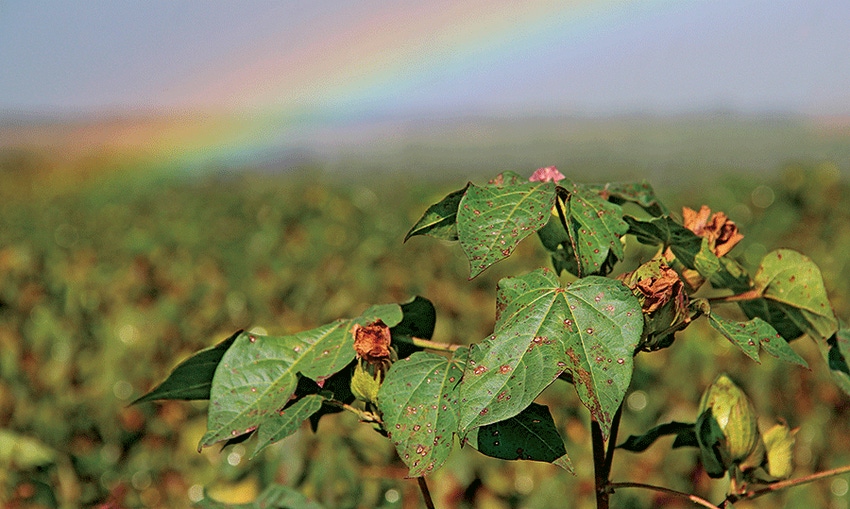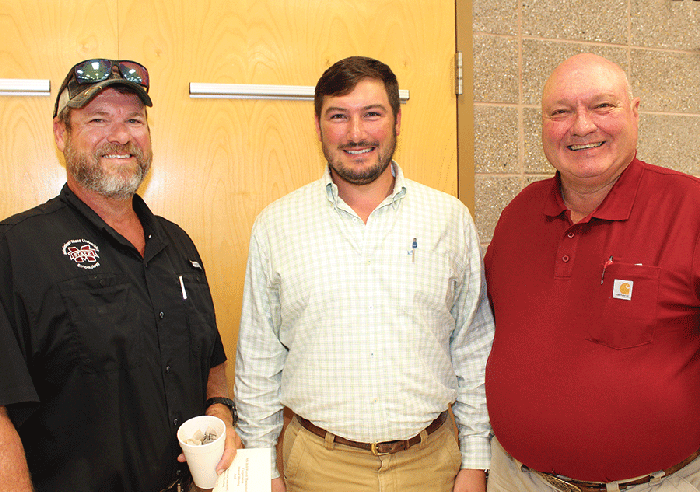
In July, many Mississippi cotton growers were contending with high bollworm egg lays from flights of moths coming out of corn into cotton fields, says Dr. Angus Catchot, Mississippi State University Extension professor of entomology and plant pathology.
“We’ve been in a bollworm flight, depending on where you are in the state, since July 3, and it shows no sign of letting up,” he said at the recent joint meeting of the Mississippi Boll Weevil Management Corporation and the Mississippi Farm Bureau Federation Cotton Policy Committee. ”I’ve had a lot of calls this morning [July 19] from producers in the south Delta area, reporting 40 percent to 50 percent egg lays. This is the second round for those folks. It’s rolling north and east, and it’s been heavy and it’s been consistent for a while.
“There’s some correlation to your proximity to corn as to whether or not you’re having these big flights. There’s no question now that we’re seeing many more bollworms survive Bt corn than we ever have before, and that’s what’s been contributing to these big flights the last couple of years. In our part of the world, all the bollworms we have in June funnel through corn, and because the Bt toxins in corn aren’t working well any more, and they’re very similar to the Bt toxins in cotton, it’s exacerbating the size of the populations that come out of corn.
"I talked yesterday [July 18] with my colleague in Arkansas, Gus Lorenz, after he'd returned from a trip to southeast Arkansas cotton fields. 'It's absolutely unbelievable,' he said. 'In my 40-something years in this business, I've never seen egg lays like this.'"

Dr. Angus Catchot, from left, Mississippi State University Extension professor of entomology and plant pathology; Kevin Brown, Mississippi Farm Bureau Federation region 5 policy coordinator; and Terry Norwood, MFBF region 2 manager, were among those attending the annual joint meeting of the Mississippi Boll Weevil Management Corporation and the MFBF Cotton Policy Committee.

PRE-SELECTED FOR SURVIVAL
Because the worms are coming through Bt corn, Catchot says, “they’re pre-selected to be able to survive in cotton because the Bt genes are similar. That’s why we’re seeing all the escapes now that we never used to see before, at least not to this extent.
“The chances of bollworm survival in Bollgard II, Widestrike, and TwinLink cotton are high, and that’s why Extension, consultants, and dealers, at least for the time being, are recommending treatment based on egg thresholds. When you start seeing 20 percent eggs, we recommend treating with diamides (Prevathon/Besiege). In some cases, we’re using Intrepid Edge at about 7 oz. to 8 oz., but primarily it’s Prevathon and Besiege. In the past, we’ve used 7 oz. of Besiege or 14 oz. of Prevathon, but this year we’re recommending rates a bit higher: 10 oz. of Besiege or 20 oz. of Prevathon. That’s our recommendation right now — and it doesn’t matter whether you’re in east Mississippi or the Delta —that’s what we feel will work, even though it costs more."
Catchot says growers want to know if using the higher rates will offer more residual protection. “That’s complicated. In some cases, I would say, maybe yes; in others, maybe no. But what we do clearly see is that we can get better initial kill with the higher rate. We’ve always been right on the edge with rates for these products, but because of the escapes that we saw in 2017, we’re recommending the higher rates this year.”
NOT FOR VIP COTTONS
But there are some caveats with the 20 percent egg lay threshold, Catchot notes. “We’re not recommending treating VIP cottons based on egg lays, whether it’s Widestrike 3, Bollgard III, or TwinLink Plus. For the time being, we’re going to give these technologies a chance to work. So, you’ve got know what’s in a field. We certainly don’t want to treat those fields based on eggs lays. I’ve had a couple of calls about Widestrike III cotton with 100 percent egg lays, asking ‘Are you sure I need to walk away from this and not spray?’ And my answer is, ‘Yes, I’m sure.’”
But, Catchot says, “Growers are spending a lot of money on diamide chemistries, and this is where it gets complicated. We know for a fact that we’re going to get between 10 days to 14 days residual on bollworms, if we can get the material to them. But if the eggs hatch and they get into the bloom tags, you’re not going to kill them. If you’ve made a diamide application and 7 days later you’re back up to 50 percent eggs, we’re recommending, because of the cost, that you don’t follow back up with another diamide application.
“Instead, if you’re inside that 14 day window, and if you still have high egg lays and escapes and feel you need to do something, we’re recommending a combination of 3/4 lb. of Orthene and a maximum rate pyrethroid. “The good news for Delta producers is that this isn’t just a worm shot — it’s still one of our top tier plant bug treatments outside of Transform, Bidrin, or Diamond. We’re doing a lot more use of Orthene in tank mixes, because it’s really good at beating back adult moths. It won’t kill the larvae, but it’s really good on the adults.
“A producer told me this morning he’s counting dead moths by the hundreds in middles three days after an Orthene/pyrethroid application. Will it stop egg lay? I don’t know, but it sure feels good to see all those dead adults in the middles.”
We would never recommend this for the initial treatment, but what we’ve seen is that you get a bit better control with that combination because you’re still getting a little bit of control from the Bt, and you still have a little bit of residual from the diamide. Once you get 12 days to 14 days out and retreatment is needed, we recommend another diamide application.
AN EXPENSIVE CROP
“Because of this, we’re going to have an expensive crop, and it frustrates me greatly that we’re paying technology fees and then still have to spend a lot more money on applications to control bollworms. But that’s the situation we’re in, at least in the short term.
“We’re hoping the answer will be to get VIP cottons on a lot of acres as quickly as we can, that this problem will go away, and that we can get away from egg thresholds and high insecticide bills to control worms that aren’t killed with the technology we’re already paying for.”
To producers already growing VIP cottons, Catchot cautions, “Don’t think because we’re recommending not to spray for eggs that the VIP cottons are bulletproof. We’ve been testing these traits for 15 years, and there are occasions where we still have to treat them. You can’t just walk away from them. But we’re not going to be recommending automatic treatments based on egg lays.”
Widespread planting of VIP corn, however, “will probably, put us right back in the situation we’re in now in just a few years,” he says. “Initially, we’ll probably see a large reduction in the bollworm population coming out of corn, but it may not take long for resistance to develop in corn.
VIP corn is available now, Catchot notes, “but it doesn’t have a lot of market share at the moment. I have a feeling the seed companies will start moving their best germplasm to this technology, and that it will be adopted very quickly. It looks good. But remember: every bollworm in the country comes through corn.
“Think about how much selection pressure we’re going to be putting on that gene. If you’re a cotton grower, it will be a problem; if you’re a corn grower, you’ll be happy for a while, even though returns will be negligible, if any, above the other Bt traits in our region.
“Cotton will pay the ultimate price for decisions that are made in corn,” Catchot says. “Companies need to think long and hard about that.”
About the Author(s)
You May Also Like




